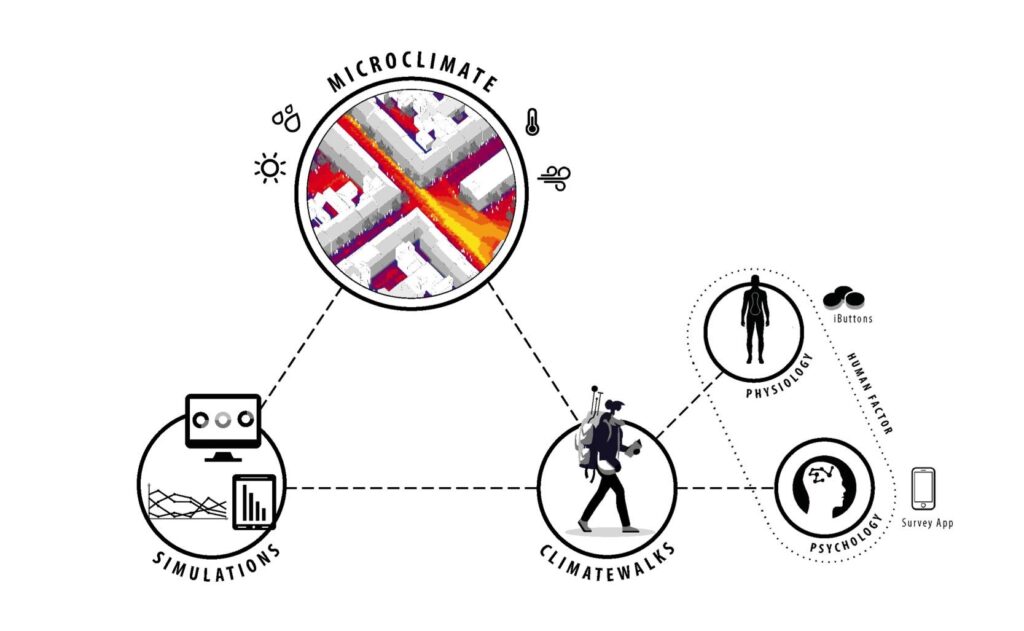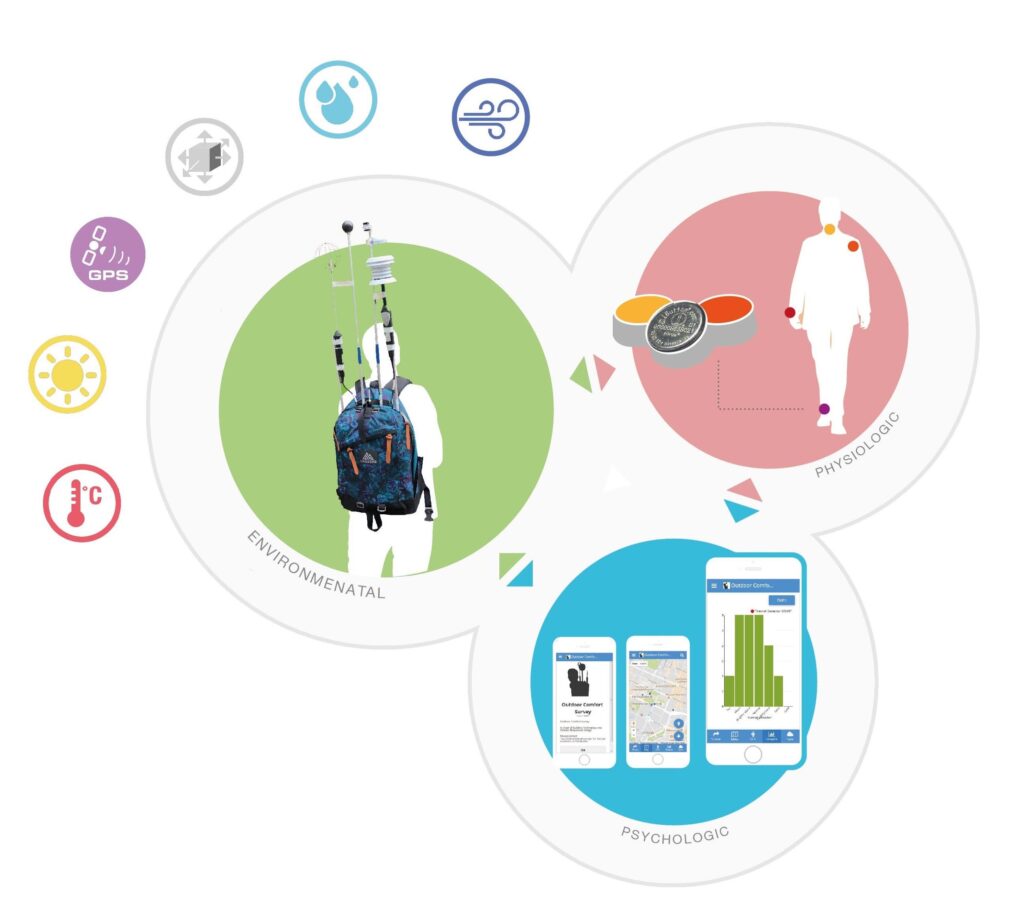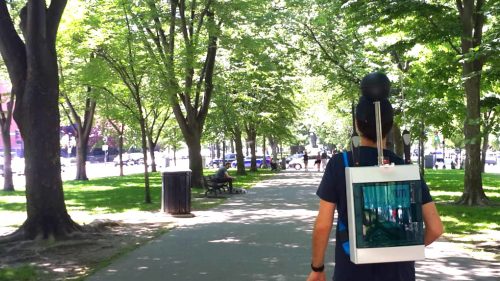Climate is the primary factor that allows the use of public spaces. In particular, microclimate describes the conditions that human beings continuously experience through their senses1. Microclimate most drastically affects conditions in cities, the places where society, economy and environment converge and where walkability, comfort and health are the most substantial indicators for appropriation, and consequently, of quality of the public realm. Particularly citizens are exposed to the consequences of discomfort in urban spaces, resulting in a high amount of challenges for the city dwellers and having serious impacts on the everyday life and well-being of hundreds of millions of people around the globe, with different impacts from place to place.
The use of public space is co-shaped by environmental and socio-technical conditions: the influence of thermal comfort on outdoor activities is a complex issue comprising both climatic and behavioural aspects. Analysing and assessing these conditions demands not only innovative computational methodologies and tools but also the exploration of new sources of information. In this context, we develop tools to gather data and methods to generate information from datasets. Digital technologies allow access to scales and quantities that inevitably enable novel opportunities.
Urban environments generate sequences of microclimates that elicit thermal experiences in the pedestrians that are complex due to the material diversity and complex morphology they encounter while navigating: urban areas are characterised by varied microclimates across very small spatial and temporal scales.
Following this premise, can we find a systematic relation between microclimate and human mobility and if so, to which extent? Digital technologies make it possible to summarise the implications for enabling transformation. In particular, in the context of reducing motorized mobility, we aim to detect interaction patterns between people and the built environment and for determining how to transform existing space with a different purpose than serving cars and in redesigning public transportation networks2.
The research area of outdoor comfort, which makes use of computation, data mining and data analysis, considers the human itself as the inseparable dimension of design.
Design, in fact, is one of the most powerful ways to favor some groups of people and disenfranchise others. It is therefore one of the most direct tools for affecting change and to create a more equitable world. The intersection of climate and design, where the implications of research in the field have the potential to highlight inequities and furnish inclusive alternatives. Climate, in particular, has far-reaching effects on poor and under-served social groups: demographically diverse insights and broad-scope thinking can influence design decisions and increase equity at scales ranging from the super-local (the building) to the neighbourhood (urban planning) to global policy.
Mapping microclimates
Methodologically, there are two main fields to evaluate and predict comfort conditions in cities: the simulation oriented and the data integrated approach. Supported by powerful computational systems and cloud computing resources, running complex and multi-scale models has become increasingly possible3. In the last decade, simulation based methods to assess microclimate are getting more common; however, the available tools are not fully capable of modelling every geometrical, physical and physiological behaviour of microclimates. Simulation based approaches often underestimate the human dimension.

Since the resolution and the quality of data represents a limitation of this approach, we aim at creating a data integrated model (Fig.1), combining it with sensing techniques to bring the human factor to the focal point (human-centred approach) in the microclimate evaluation4. The idea of approaching the problem from a human-centred perspective studies the phenomena of microclimate in a higher resolution in terms of human interactions with climatic conditions and urban structures. This approach works as bottom-up system placing humans at the centre of responsiveness considering needs, impacts and influences to start addressing solutions.
Studies on microclimate of cities have already proved that pedestrian thermal comfort is a function of the built environment; understanding these phenomena requires both numerical techniques and field measurements to achieve comfortable, healthier and more liveable urban spaces5. The application of thermal comfort monitoring in transient conditions is limited due to complexity of the task and instrumental setup, which leads to a lack of understanding about how pedestrians compensate for discomfort6. One of the main challenges of data integrated methods is the availability and quality of datasets since most of them by default are not gathered specifically for human comfort evaluations. So one of the effective ways is to collect the data in diverse domains knowing the hypothesis and the questions that the data is going to address at the end.
Field measurements are a fundamental method which had been integrated in different studies we conducted on outdoor environmental quality. These experiments, we called Climatewalks, bring the human scale to the center of our observation. The Climatewalk experiments are designed to evaluate subjective behaviour of people in transient conditions. The methodology is applied in several cities: Munich, Seville, Malaga, Hong Kong, Singapore, Rome, Genova, Copenhagen, Boston and Barcelona. Climatewalks are designed to measure environmental factors with a mobile meteorological station equipped with environmental sensor and GPS tracking data loggers, to measure and map transient condition in different seasonal scenarios. By relating individual and subjective responses to environmental conditions adaptation, the experiment allows to relate microclimatic conditions to human thermal behaviour in urban spaces. The objective of the ongoing research, is to provide thermal understanding of the responses of pedestrians when walking in outdoor environment using a geo-referenced method for monitoring and mapping of microclimate and a longitudinal survey to obtain the thermal responses of pedestrians, for improving the “climatic knowledge” of the urban context7.

Figure 2 shows the graphical setup of the methods merging environmental, physiological and psychological domains to have a human-centered approach to monitor and map microclimate and outdoor comfort in cities. The novelty of our workflow is the combining of existing techniques for understanding the complex interplay that determines confluence in a specific place and to put into evidence the effects of urban morphology on citizens. In particular, we can measure transient conditions from outdoor to indoor, and highlight the implications, on indoor conditioning measures and strategies for climate mitigation. Furthermore, these techniques allow to provide a vision for the cities of the future, aiming at creating vibrant and healthy environments for people, to mitigate thermal stress and also preparing to recover from more frequent and more extreme climatic phenomena4. The idea of approaching the problem from human-centered perspective studies the phenomena of microclimate in higher resolution in terms of human interactions with climatic conditions and urban structures. Furthermore this approach works as bottom-up system placing human at the center of responsiveness considering needs, impacts and influences to start addressing solutions. The method is able to quantify self-regulating location-based design recommendations in different contexts and allows to generate knowledge about the influence of thermal pleasure on people flows and to design more vibrant and attractive public spaces.
References
- Santucci, D., Chokhachian, A., Lau, K., Schiavon, S., Pallubinsky, H., Auer, T. (2019) Evaluation of psychological and physiological response to transient comfort conditions in Singapore. Comfort at the Extremes: Energy, Economy and Climate Conference Proceedings, April 2019.
- Bongiorno, C., Santucci, D., Kon, F., Santi, P. and Ratti, C. (2019) Comparing bicycling and pedestrian mobility: Patterns of non-motorized human mobility in Greater Boston. Journal of Transport Geography, Volume 80, 2019.
- Nazarian, N., Acero, J.A., Norford, L. (2019) Outdoor thermal comfort autonomy: Performance metrics for climate-conscious urban design. Building and Environment.
- Chokhachian, A., Santucci, D., Auer, T. (2017) A Human-Centered Approach to Enhance Urban Resilience, Implications and Application to Improve Outdoor Comfort in Dense Urban Spaces. Buildings 4(7): 113.
- De Dear, R., & Brager, G. S. (1998). Developing an adaptive model of thermal comfort and preference.
- Fiala, D., Lomas, K.J., Stohrer, M. (2003) First principles modeling of thermal sensation responses in steady-state and transient conditions. ASHRAE transactions, 109, p.179.
- Chokhachian, A., Lau, K. K. L., Perini, K., & Auer, T. (2018). Sensing transient outdoor comfort: A georeferenced method to monitor and map microclimate. Journal of Building Engineering, 20, 94-104.

